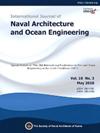单桩海上风力发电机组冰激振动特性综合分析
IF 3.9
3区 工程技术
Q2 ENGINEERING, MARINE
International Journal of Naval Architecture and Ocean Engineering
Pub Date : 2025-01-01
DOI:10.1016/j.ijnaoe.2025.100687
引用次数: 0
摘要
寒冷地区海上风力发电的快速发展推动了涡轮机向深海部署,但冰荷载对结构安全提出了严峻挑战。为了准确预测冰-风耦合作用下海上风力发电机组的动力响应,提出了一种离散元法-风力发电机组集成分析(DEM-WTIA)方法。该方法通过建立旋翼和控制系统的集成模型,同步模拟冰破碎过程和气动结构动力响应。研究结果表明:该模型准确地捕捉了冰破碎过程中的瞬态能量耗散,表征了冰-风波载荷非线性叠加的高低频耦合效应;塔顶位移对冰荷载的敏感性显著超过基础位移;在无风/切断风速(3 ~ 5 m/s)条件下,冰主导了塔的振动,而在额定/切断风速下,气动阻尼抑制了冰引起的振动;频谱分析表明,随着风力的增加,主导位移频率从0.27 Hz(接近wt基频)转变为0.24 Hz;敏感性分析表明,在停车模式下,冰厚敏感性指数(35.6)远远超过冰速敏感性指数(7.2);抗冰设计确定70°锥角为最佳的单桩基础。该研究为寒冷海域海上风结构的防冰设计提供了重要的理论支持和新的模拟方法,为远海风电场规划提供了关键的技术指导。本文章由计算机程序翻译,如有差异,请以英文原文为准。
Integrated analysis of ice-induced vibration characteristics of monopile offshore wind turbines
The rapid development of offshore wind power in cold regions drives turbine deployment into deep-sea areas, yet ice-induced loads pose severe challenges to structural safety. This study aims to accurately predict dynamic responses of offshore wind turbines under ice-wind coupling, proposing a Discrete Element Method-Wind Turbine Integrated Analysis (DEM-WTIA) approach. This method synchronously simulates ice fragmentation processes and aero-structural dynamic responses by constructing an integrated model with rotor and control systems. Findings reveal: The model precisely captures transient energy dissipation during ice crushing and characterizes high-low frequency coupling effects with nonlinear superposition of ice-wind-wave loads; Tower-top displacement sensitivity to ice loads significantly exceeds foundation displacement; Under no-wind/cut-in wind speeds (3–5 m/s), ice dominates tower vibration, while aerodynamic damping suppresses ice-induced vibrations at rated/cut-out speeds; Spectral analysis shows dominant displacement frequency shifts from 0.27 Hz (near OWT fundamental frequency) to 0.24 Hz as wind increases; Sensitivity analysis indicates ice thickness sensitivity index (35.6) far exceeds ice velocity (7.2) in parked mode; Anti-ice design identifies 70° cone angle as optimal for monopile foundations. This research provides critical theoretical support and a novel simulation method for anti-ice design of offshore wind structures in cold seas, offering key technical guidance for far-sea wind farm planning.
求助全文
通过发布文献求助,成功后即可免费获取论文全文。
去求助
来源期刊

International Journal of Naval Architecture and Ocean Engineering
ENGINEERING, MARINE-
CiteScore
4.90
自引率
4.50%
发文量
62
审稿时长
12 months
期刊介绍:
International Journal of Naval Architecture and Ocean Engineering provides a forum for engineers and scientists from a wide range of disciplines to present and discuss various phenomena in the utilization and preservation of ocean environment. Without being limited by the traditional categorization, it is encouraged to present advanced technology development and scientific research, as long as they are aimed for more and better human engagement with ocean environment. Topics include, but not limited to: marine hydrodynamics; structural mechanics; marine propulsion system; design methodology & practice; production technology; system dynamics & control; marine equipment technology; materials science; underwater acoustics; ocean remote sensing; and information technology related to ship and marine systems; ocean energy systems; marine environmental engineering; maritime safety engineering; polar & arctic engineering; coastal & port engineering; subsea engineering; and specialized watercraft engineering.
 求助内容:
求助内容: 应助结果提醒方式:
应助结果提醒方式:


